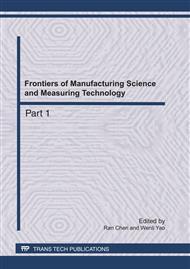p.352
p.357
p.362
p.367
p.372
p.377
p.384
p.389
p.395
Design of a Torsional Dynamic Absorber Using Magnetorheological Elastomers for Powertrain Vibration Control
Abstract:
This paper presents the design of torsional adaptive tunable vibration absorber (ATVA) using magnetorheological elastomers (MREs) for vibration reduction of powertrain systems. The MRE used for the ATVA development consists of a silicone polymer, silicone oil and magnetic particles with the weight fractions are 60%, 20%, 20%, respectively. Experimental testing is conducted to measure MRE Young’s modulus and damping ratio. With the MRE, a dynamic absorber design is proposed for powertrain vibration reduction and the parameters of magnetic circuit such as the number of turns of coils can be determined. Also, the mechanical parameters of the dynamic absorber are designed. In addition, the ATVA effectiveness is investigated through simulations, which is useful to optimize ATVA parameters to develop the ATVA.
Info:
Periodical:
Pages:
372-376
Citation:
Online since:
May 2011
Price:
Сopyright:
© 2011 Trans Tech Publications Ltd. All Rights Reserved
Share:
Citation:


